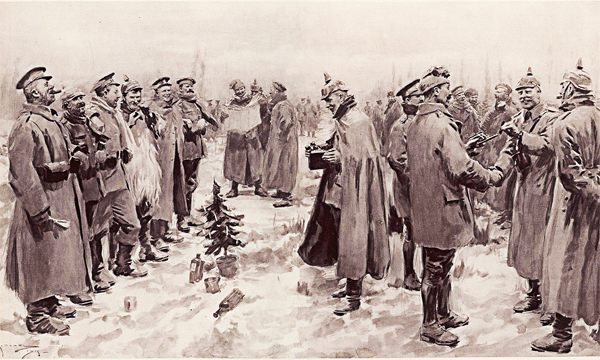
The World War I Christmas Truce on December 24-26, 1914
The World War I Christmas Truce: “Here we were laughing and chatting to men whom only a few hours before we were trying to kill!”
On Christmas Eve 1914, in the dank, muddy trenches on the Western Front of the first world war, a remarkable thing happened.
It came to be called the Christmas Truce. And it remains one of the most storied and strangest moments of the Great War - or of any war in history.
British machine gunner Bruce Bairnsfather, later a prominent cartoonist, wrote about it in his memoirs. Like most of his fellow infantrymen of the 1st Battalion of the Royal Warwickshire Regiment, he was spending the holiday eve shivering in the muck, trying to keep warm. He had spent a good part of the past few months fighting the Germans. And now, in a part of Belgium called Bois de Ploegsteert, he was crouched in a trench that stretched just three feet deep by three feet wide, his days and nights marked by an endless cycle of sleeplessness and fear, stale biscuits and cigarettes too wet to light.
“Here I was, in this horrible clay cavity,” Bairnsfather wrote, “…miles and miles from home. Cold, wet through and covered with mud.” There didn’t “seem the slightest chance of leaving—except in an ambulance.”
Then the singing started
At about 10 p.m., Bairnsfather noticed a noise.
“I listened”, he recalled. “Away across the field, among the dark shadows beyond, I could hear the murmur of voices.” He turned to a fellow soldier in his trench and said, “Do you hear the Boches [Germans] kicking up that racket over there?”
“Yes”, came the reply. “They’ve been at it some time!”
The Germans were singing carols, as it was Christmas Eve. In the darkness, some of the British soldiers began to sing back.
“Suddenly”, Bairnsfather recalled, “we heard a confused shouting from the other side. We all stopped to listen. The shout came again.” The voice was from an enemy soldier, speaking in English with a strong German accent. He was saying, “Come over here.”
One of the British sergeants answered:
“You come half-way. I come half-way.”
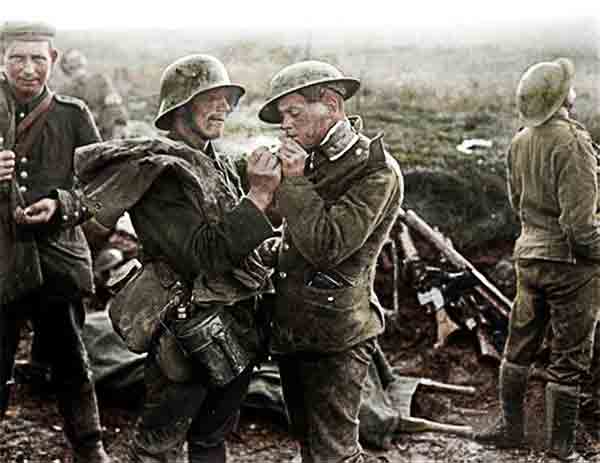
Continued ...
History Channel / Wikipedia / Encyclopedia Britannica /
Imperial War Museum (Great Britain) / The National Museum and Memorial.org / Mises Institute.org / Ohio History Connection.org /
Libertarian Institute.org / Smithsonian /
The World War I Christmas Truce on December 24-26, 1914 (YouTube) 
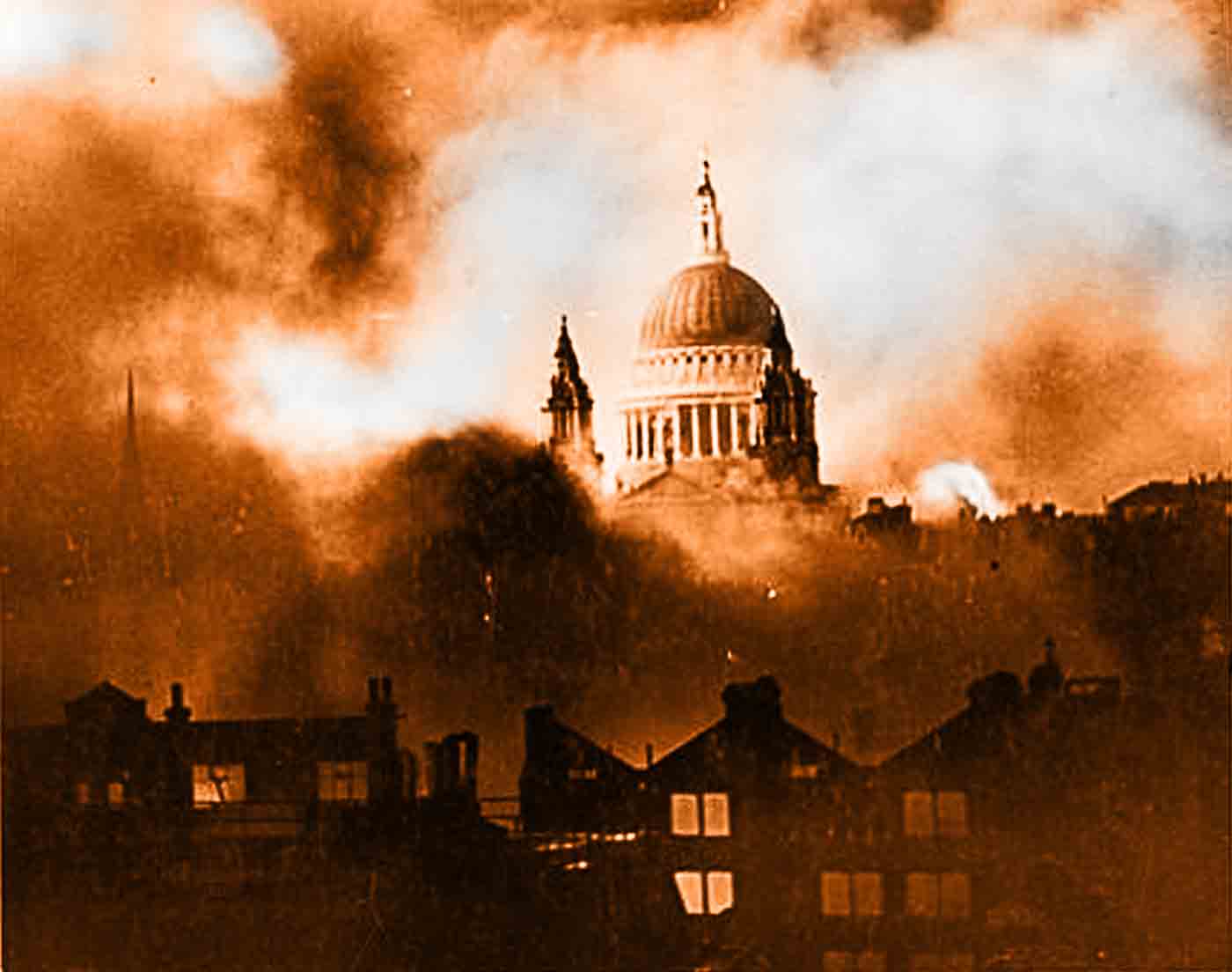
Worst air raid on London on December 29, 1940
Worst air raid on London: Battle of Britain: On the evening of December 29, 1940, London suffers its most devastating air raid when Germans firebomb the city. Hundreds of fires caused by the exploding bombs engulfed areas of London, but firefighters showed a valiant indifference to the bombs falling around them and saved much of the city from destruction. The next day, a newspaper photo of St. Paul’s Cathedral standing undamaged amid the smoke and flames seemed to symbolize the capital’s unconquerable spirit during the Battle of Britain.
In May and June 1940, Holland, Belgium, Norway, and France fell one by one to the German Wehrmacht, leaving Great Britain alone in its resistance against Nazi leader Adolf Hitler’s plans for world domination. The British Expeditionary Force escaped the continent with an impromptu evacuation from Dunkirk, but they left behind the tanks and artillery needed to defend their homeland against invasion. With British air and land forces outnumbered by their German counterparts, and U.S. aid not yet begun, it seemed certain that Britain would soon follow the fate of France. However, Winston Churchill, the new British prime minister, promised his nation and the world that Britain would “never surrender,” and the British people mobilized behind their defiant leader.

On June 5, the Luftwaffe began attacks on English Channel ports and convoys, and on June 30 Germany seized control of the undefended Channel Islands. On July 10 - the first day of the Battle of Britain according to the RAF–the Luftwaffe intensified its bombing of British ports. Six days later, Hitler ordered the German army and navy to prepare for Operation Sea Lion. On July 19, the German leader made a speech in Berlin in which he offered a conditional peace to the British government: Britain would keep its empire and be spared from invasion if its leaders accepted the German domination of the European continent. A simple radio message from Lord Halifax swept the proposal away.
Germany needed to master the skies over Britain if it was to transport safely its superior land forces across the 21-mile English Channel. On August 8, the Luftwaffe intensified its raids against the ports in an attempt to draw the British air fleet out into the open. Simultaneously, the Germans began bombing Britain’s sophisticated radar defense system and RAF-fighter airfields. During August, as many as 1,500 German aircraft crossed the Channel daily, often blotting out the sun as they flew against their British targets. Despite the odds against them, the outnumbered RAF fliers successfully resisted the massive German air invasion, relying on radar technology, more maneuverable aircraft, and exceptional bravery. For every British plane shot down, two Luftwaffe warplanes were destroyed.
At the end of August, the RAF launched a retaliatory air raid against Berlin. Hitler was enraged and ordered the Luftwaffe to shift its attacks from RAF installations to London and other British cities. On September 7, the Blitz against London began, and after a week of almost ceaseless attacks several areas of London were in flames and the royal palace, churches, and hospitals had all been hit. However, the concentration on London allowed the RAF to recuperate elsewhere, and on September 15 the RAF launched a vigorous counterattack, downing 56 German aircraft in two dogfights that lasted less than an hour.
The costly raid convinced the German high command that the Luftwaffe could not achieve air supremacy over Britain, and the next day daylight attacks were replaced with nighttime sorties as a concession of defeat. On September 19, Nazi leader Adolf Hitler postponed indefinitely “Operation Sea Lion”–the amphibious invasion of Britain. The Battle of Britain, however, continued.
History.com / Wikipedia / Encyclopedia Britannica / Museum of London.org UK / BBC
/ Engineering and Technology History (ETHW).org / Smithsonian National Air and Space Museum / History.com
/ Worst air raid on London on December 29, 1940 (YouTube) 

Pearl Harbor bombed on December 7, 1941
Pearl Harbor bombed At 7:55 a.m. Hawaii time, a Japanese dive bomber bearing the red symbol of the Rising Sun of Japan on its wings appears out of the clouds above the island of Oahu. A swarm of 360 Japanese warplanes followed, descending on the U.S. naval base at Pearl Harbor in a ferocious assault. The surprise attack struck a critical blow against the U.S. Pacific fleet and drew the United States irrevocably into World War II.
With diplomatic negotiations with Japan breaking down, President Franklin D. Roosevelt and his advisers knew that an imminent Japanese attack was probable, but nothing had been done to increase security at the important naval base at Pearl Harbor. It was Sunday morning, and many military personnel had been given passes to attend religious services off base. At 7:02 a.m., two radar operators spotted large groups of aircraft in flight toward the island from the north, but, with a flight of B-17s expected from the United States at the time, they were told to sound no alarm. Thus, the Japanese air assault came as a devastating surprise to the naval base.
Much of the Pacific fleet was rendered useless: Five of eight battleships, three destroyers, and seven other ships were sunk or severely damaged, and more than 200 aircraft were destroyed. A total of 2,400 Americans were killed and 1,200 were wounded, many while valiantly attempting to repulse the attack. Japan’s losses were some 30 planes, five midget submarines, and fewer than 100 men. Fortunately for the United States, all three Pacific fleet carriers were out at sea on training maneuvers. These giant aircraft carriers would have their revenge against Japan six months later at the Battle of Midway, reversing the tide against the previously invincible Japanese navy in a spectacular victory.

The day after Pearl Harbor was bombed, President Roosevelt appeared before a joint session of Congress and declared, “Yesterday, December 7, 1941–a date which will live in infamy–the United States of America was suddenly and deliberately attacked by naval and air forces of the Empire of Japan.” After a brief and forceful speech, he asked Congress to approve a resolution recognizing the state of war between the United States and Japan. The Senate voted for war against Japan by 82 to 0, and the House of Representatives approved the resolution by a vote of 388 to 1. The sole dissenter was Representative Jeannette Rankin of Montana, a devout pacifist who had also cast a dissenting vote against the U.S. entrance into World War I. Three days later, Germany and Italy declared war against the United States, and the U.S. government responded in kind.
The American contribution to the successful Allied war effort spanned four long years and cost more than 400,000 American lives.
History Channel / Wikipedia / Encyclopedia Britannica / Pearl Harbor Oahu / National Park Service
/ Pearl Harbor - Dec. 7, 1941 - The only color film of the attack (YouTube)” 

Understanding Military Terminology
Rationalization
(DOD) Any action that increases the effectiveness of allied forces through more efficient or effective use of defense resources committed to the alliance.
Joint Publications (JP 3-16) Multinational Operations
R-day
(DOD) Redeployment day.
Reachback
(DOD) The process of obtaining products, services, and applications, or forces, or equipment, or material from organizations that are not forward deployed.
Joint Publications (JP 3-30) Command and Control of Joint Air Operations
Readiness
(DOD) The ability of military forces to fight and meet the demands of assigned missions.
See also National Military Strategy.
Joint Publications (JP 1) Doctrine for the Armed Forces of the United States
Joint Publication - Department of Defense Dictionary of Military and Associated Terms
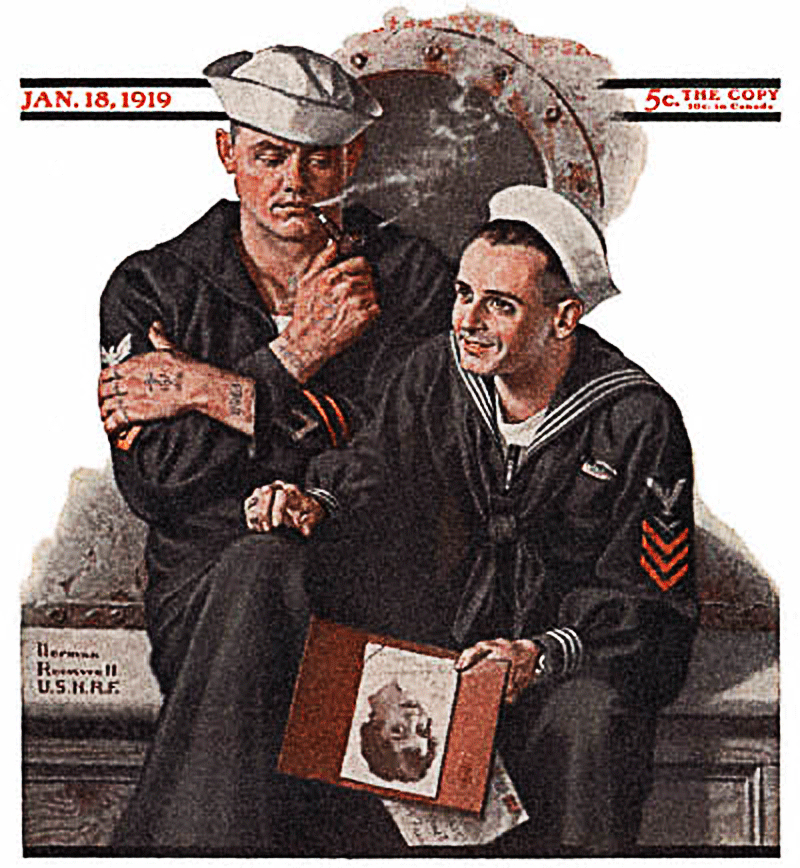
The Old Salt’s Corner

A Sailor's Christmas
Twas the night before Christmas a calm night at sea,
We nestled in our racks for a Holiday Routine.
When from the ventilation there came such a clatter,
We jumped from our bunks to see what's the matter.
When from the vent fell this big dust covered dude,
He was dressed up in red with a bad attitude.
Yelling, “Those ducts are all filthy!” as he brushed off his clothes,
“Don't just damn stand there, where's the DCPO?”
He arose from the deck, then he peered all around,
Then from his mouth came a bellowing sound.
”This berthing's a disgrace!” then he called us by name,
“Now Boatswain, Now Corpsman, please explain!”
This was not the Santa I remembered from youth,
He smelled of cheap whiskey, he was rough and uncouth.
”Now, look here you bastards” he said as he strolled,
“You'd best trice this place up, or you'll get nothing but coal!”
“You'll make this space pretty, military, and neat!”
Then he looked down at our boots that lay right near his feat.
”Well, what do we have here?” he said with a frown,
“Who the hell polished these? Recruit 'Buster brown'?!”
He walked around slowly, he missed not a mark.
He even spotted dust bunnies, right there in the dark!
”You've got high dust and low dust, and that overhead it needs cleaning!”
We all stood dumbfounded as his words kept on streaming.
“Which man here is senior!?” Then asked St Nick,
“You'd better shit me and answer…and SHIT ME ONE QUICK!”
The First Class stepped forward, his heart pounding hard,
“Now look right here shitbirds, this asshole's in charge!”
“These racks will be tight! This damn deck it will shine!
I don't want to hear bitching! I need not hear you whine!”
So we gathered our foxtales, our buckets, and swabs,
We all worked all in silence to finish the job.
It took almost an hour finish our space,
He just sat drinking coffee and stuffing his face.
Then on re-inspection he explained with a huff,
“Now this is more like it! Now you’re not so screwed up!”
We all stood there smiling, awaiting our gifts,
But Santa just snapped out “What's the matter dumb-shits!?”
“Get back to your racks! This will be my last warning!
Just like on shore, the gifts come in the morning!”
It seemed like eternity until reveille sounded,
We threw back our curtains as all our hearts pounded.
But what were our gifts? For what did we suffer?
A pallet of rags and a shiny new buffer!
Attached to our new buffer, we found a short note,
We all gathered 'round to see what he wrote.
“Next year at Christmas, best have all your shit wired!”
Signed:
Fair Winds
S.C. Clause
BMCM (Retired)

“I’m Just Sayin”
“Put your ear down close to your soul and listen hard.”
“The joy that isn't shared dies young.”
“Death's in the good-bye.”
“God owns heaven but He craves the earth.”
“Live or die,
but don't poison everything.”
“Even without wars,
life is dangerous.”
“Even though I'm often crazy
- and I am,
and I know it
- still I fight it because I know how sterile,
how futile,
how bleak...
nothing grows from it,
and you,
meanwhile,
only grow into it like a snail.”
~ Anne Sexton

“Thought for the Day”
“I learned the value of hard work by working hard.”
“We won't have a society if we destroy the environment.”
“Always remember that you are absolutely unique.
Just like everyone else.”
“Every time we liberate a woman,
we liberate a man.”
“What people say,
what people do,
and what they say they do are entirely different things.”
“Never doubt that a small group of thoughtful,
committed citizens can change the world;
indeed,
it's the only thing that ever has.”
~ Margaret Mead

“What I Learned”
“Justice in the extreme is often unjust.”
“There are no secrets that time does not reveal.”
“A noble heart cannot suspect in others the pettiness and malice that it has never felt.”
“There is nothing so easy but that it becomes difficult when you do it with reluctance.”
“Nothing is so difficult but that it may be found out by seeking.”
“On the throne,
one has many worries;
and remorse is the one that weighs the least.”
~ Jean Racine
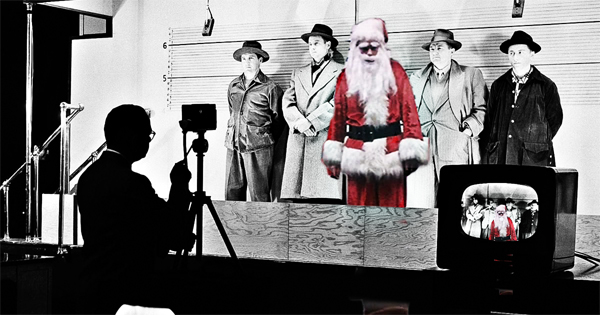
Mr. Answer Man Please Tell Us: Santa Claus Bank Robbery on December 23, 1927
Santa Claus Bank Robbery: At the time it occurred, the Santa Claus Bank Robbery was one of Texas' most infamous crimes and led to the largest manhunt ever seen in the state. It all began on December 23, 1927, around noon when Marshall Ratliff, Henry Helms, Robert Hill, all ex-cons, and Louis Davis, a relative of Helms, held up the First National Bank in Cisco.
Ratliff had been caught with his brother Lee after robbing a bank in Valera, and they had each served only a year of their sentences before being pardoned by Governor Miriam A. Ferguson. They had planned to rob the Cisco bank together, but Lee had already been arrested again.
So Marshall pulled in Helms and Hill, whom he knew from Huntsville, and a fourth man who was good with safes. As they planned the crime in Wichita Falls, the safe-cracker came down with the flu, and the trio pulled in Davis, a family man in need, with the offer of big money.
The four stole a car in Wichita Falls and headed for Cisco. They arrived on the morning of December 23 and prepared to make themselves some easy money, or so they thought.
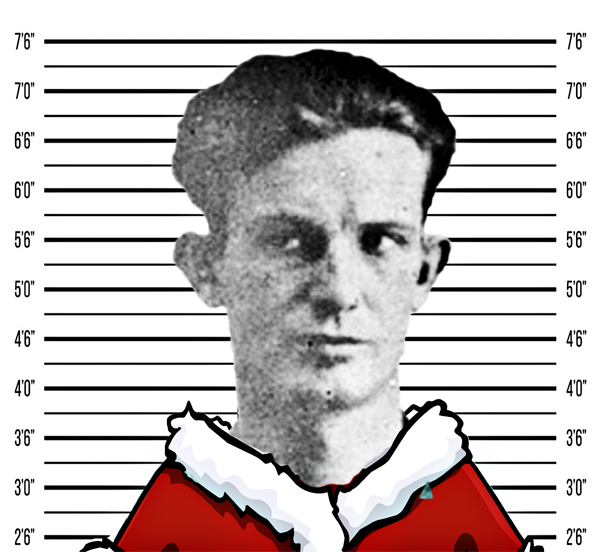
During this period three or four Texas banks a day were being robbed, and in response, the Texas Bankers Association had offered a $5,000 reward to anyone shooting a bank robber during the crime. It was partly this reward that turned a simple bank robbery into a deadly crime.
As the group neared the bank, Ratliff donned a Santa Claus suit he had borrowed from Mrs. Midge Tellet, who ran the boarding house where they had been staying in Wichita Falls. They let Ratliff out several blocks from the bank.
Followed by children attracted to “Santa”, Ratliff joined the other three in an alley and led the way into the bank.
Continued ...
Texas State Historical Association
• The Texan
• Mental Floss
• Wikipedia
• Santa Claus Bank Robbery on December 23, 1927 (YouTube Search) 

Mr. Answer Man Please Tell Us: The Origins of Christmas
Christmas is both a sacred religious holiday and a worldwide cultural and commercial phenomenon. For two millennia, people around the world have been observing it with traditions and practices that are both religious and secular in nature. Christians celebrate Christmas Day as the anniversary of the birth of Jesus of Nazareth, a spiritual leader whose teachings form the basis of their religion. Popular customs include exchanging gifts, decorating Christmas trees, attending church, sharing meals with family and friends and, of course, waiting for Santa Claus to arrive. December 25 - Christmas Day - has been a federal holiday in the United States since 1870.
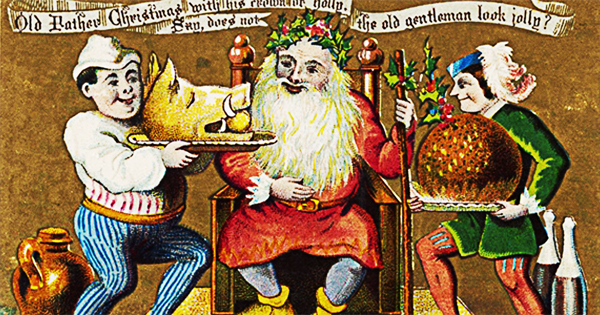
An Ancient Holiday
The middle of winter has long been a time of celebration around the world. Centuries before the arrival of the man called Jesus, early Europeans celebrated light and birth in the darkest days of winter. Many peoples rejoiced during the winter solstice, when the worst of the winter was behind them and they could look forward to longer days and extended hours of sunlight.
In Scandinavia, the Norse celebrated Yule from December 21, the winter solstice, through January. In recognition of the return of the sun, fathers and sons would bring home large logs, which they would set on fire. The people would feast until the log burned out, which could take as many as 12 days. The Norse believed that each spark from the fire represented a new pig or calf that would be born during the coming year.
The end of December was a perfect time for celebration in most areas of Europe. At that time of year, most cattle were slaughtered so they would not have to be fed during the winter. For many, it was the only time of year when they had a supply of fresh meat. In addition, most wine and beer made during the year was finally fermented and ready for drinking.
In Germany, people honored the pagan god Oden during the mid-winter holiday. Germans were terrified of Oden, as they believed he made nocturnal flights through the sky to observe his people, and then decide who would prosper or perish. Because of his presence, many people chose to stay inside.
Continued ...
History Channel / Wikipedia / Encyclopedia Britannica /
History Cooperative.org / Got Questions.org / Live Science / Mental Floss / Quora /
The Origins of Christmas (YouTube) 

Mr. Answer Man Please Tell Us: How Much Weight Would Santa Gain From Eating Milk and Cookies?
This is a simple question for the Factor Label Method. This method, also known as dimensional analysis or unit analysis, make problems a breeze. I highly recommend it to anyone interested in doing seemingly hard math problems like this one. Here’s how you use it:
1. Write your given “1 Santa Claus” - on the left side of your paper
2. Write your desired answer “pounds” - on the right side of your paper
3. Make a chain of units from left to right (no numbers required).
4. Fill in the numbers
5. Multiply by all the tops (numerators)
6. Divide by all the bottoms (denominators)
7. Clean up
In just 7 simple steps you’ve got an answer. Here’s my answer. (Note: I assumed a cookie has 200 calories and a glass of milk has 100 calories. Your results will vary based on the type of cookie. I also assumed around 2 billion houses.) Here’s my Factor Label Method:

Answer: 400,000,000 pounds.

One of the best things about mathematics of this kind is that, by approximating in this way, you can see the magnitude of your answer. This answer is 400 million pounds, but it might be 300 or 500 million, depending on your assumptions.
But for the real world, the Factor Label Method is the next best thing to magic.
Forbes
• Quara
• Spoon University
• Wikipedia
• How Much Weight Would Santa Gain From Eating Milk and Cookies? (YouTube Search) 

NAVSPEAK aka U.S. Navy Slang
Three Frame Rule: Refers to a sailor or situation that is inherently dangerous.
A frame on a ship is its ribs and they are set a certain distance apart so if your ships frames are 3’ apart the rule is 9’. As in:
“BM2 keeps parting lines on the capstan. I’m putting a three frame rule on him. I don’t want to die.”
Three Steel Balls: Meant to be humorous but oddly accurate reference to a sailor or situation acting like a sailor:
“Put a sailor in a room with three steel balls.
Come back an hour later: one will be missing, one will be broken, and one will be in his pocket.”
In an alternative version one will be pregnant.
Tiger Team: Junior enlisted of all ratings (E-3 and below) who are tasked to clean the engine room prior to inspection, such as GITMO Refresher training or evaluation.
Tin can: Destroyer. Designated Driver, from DD.
Tin Chicken: U.S. Merchant Marine Officer Insignia on a U.S. Naval Officers uniform, often worn above the SWO pin.
The beak of the eagle can be used as an emergency bottle opener.
Wiktionary.org

Just for you MARINE
Thousand-Yard Stare: Thousand-yard stare unfocused gaze of a battle-weary servicemember.
Thump Gun: Grenade launcher, from the distinctive noise made when firing. See also “Blooper”.
TIC: Troops In Contact.
Tie-ties: Straps or strings used to tie items to another line, such as laundry or rifle targets.
Tight-jawed: Angry, fso named from the human tendency to “clench the jaw when angered.
Tip of the Spear: Term for a unit or subunit that enters enemy territory first.
Wikipedia.org

Naval Aviation Squadron Nicknames
HSM-79 Helicopter Maritime Strike (HSM) Squadron SEVEN NINE - nicknamed the “Griffins”
United States Navy - Marine Corps Commander, Helicopter Maritime Strike Wing Pacific - Naval Air Station North Island, Naval Base Coronado (NBC) in San Diego County, California. / HSM-79: June 02, 2016 - present

Where Did That Saying Come From?

“A journey of a thousand miles begins with a single step:”
Meaning: The proverb “a journey of a thousand miles begins with a single step” puts forward the notion that, however difficult a task is, you can only complete it if you first start it.
History: This proverbial saying is a classic of the sort that gets put onto posters and into self-help books as an inspirational thought. Many similar proverbs, for instance:
the darkest hour is just before the dawn,
speak softly and carry a big stick
a picture paints a thousand words...
are wrongly assumed to have an ancient Chinese origin.
“A journey of a thousand miles begins with a single step” is different in that it actually was coined in China. Any saying that is associated with ancient China is generally labelled as being the work of Confucius. This one isn't.
Westerners, who don't speak Chinese and have no real knowledge or understanding of Chinese history and culture, need to tread carefully when making pronouncements about who did what in China over two thousand years ago.
What is generally accepted by scholars with a better grasp of Chinese and China is this...
The proverb “A journey of a thousand miles begins with a single step” is first found in the Tao Te Ching, which is a classical Chinese Taoist text usually credited to Laozi (a.k.a. Lao Tzu), and probably written between the 4th and 6th century BC. The original text is:
“A journey of a thousand li [a Chinese mile] starts beneath one's feet”
The Tao Te Ching, is not a neatly bound and dated book with a definitive ISBN number that you might buy on Amazon. There are numerous fragmentary copies differing in content, language and authorship and dating over several centuries. The authorship is uncertain and disputed and some scholars dispute even the existence of Lao Tzu, claiming him to be mythical sage rather than a real living person.
We might usefully consider the Tao Te Ching as having a similar standing in Chinese culture as Aesop's Fables has in the West. It is now widely believed that Aesop's Fables weren't written by one author and, even if they were, it wasn't Aesop who may well not have existed in the flesh.
The “self-help” nature of the phrase has led to some parody, including this from the Anglo/Australian writer Kathy Lette:
“A journey of self-discovery starts with a single step…
But so does falling down a flight of stairs.”
Phrases.org.uk

Science & Technology

FEATURED: Gaming graphics card allows faster, more precise control of fusion energy experiments
• Silicon with a two-dimensional structure
Antimatter from laser pincers
• An autonomous system to assemble reconfigurable robotic structures in space
• Smartphone screens effective sensors for soil or water contamination
Excess coffee use shown to decrease brain volume, increase dementia risk
• AI models to analyze cancer images take shortcuts that introduce bias
• Disagreement may be a way to make online content spread faster, further
Scientists reverse age-related memory loss in mice
• Survival after cardiac arrest: Cardiovascular surgeons develop a new technique
• Informing policy for long-term global food security
Phys.org / MedicalXpress / TechXplore

NASA’s Perseverance rover to drill first samples of martian rock
• FEATURED: Your sweaty fingertips could help power the next generation of wearable electronics
Astronomers spy possible moons in the making in a distant star system
• Blood tests could help screen anticipated flood of patients seeking new Alzheimer’s drug
DNA pulled from thin air identifies nearby animals
• When will COVID-19 vaccines be fully approved - and does it matter whether they are?
How COVID-19 has transformed scientific fieldwork
• How scientists are subtracting race from medical risk calculators
Science AAAS

Bizarre News (we couldn’t make up stuff this good - real news story)
“Alien abduction” stories may come from lucid dreaming, study hints

People have described bizarre extraterrestrial encounters that take place in a dreamlike state.
Lucid dreaming, in which people are partially aware and can control their dreams during sleep, could explain so-called alien abduction stories, a study suggests.
Claims of such abductions date to the 19th century; the circumstances of the kidnappings often sound dreamlike and trigger feelings of terror and paralysis. Certain dream states are also known to produce such feelings, leading Russian researchers to wonder if dream experiments could provide clues about alleged extraterrestrial experiences.
The scientists prompted lucid dreamers to dream about encounters with aliens or unidentified flying objects (UFOs), and found that a number of sleepers reported dreams that resembled actual descriptions of alleged alien abductions.

During lucid dreams, sleepers are aware they are dreaming and can then use that awareness to manipulate what happens in the dream. About 55% of people experience lucid dreaming once or more in their lifetimes, and 23% have lucid dreams at least once a month, according to a 2016 study in the journal Consciousness and Cognition that analyzed five decades' worth of sleep research.
Recently, researchers with the Phase Research Center (PRC), a private facility in Moscow that researches lucid dreaming, conducted experiments with 152 adults who self-identified as lucid dreamers, instructing them to “find or summon aliens or UFOs” during a lucid dream, the scientists reported July 2 in the International Journal of Dream Research.
The researchers found that 114 of the participants reported dreaming about having some type of successful interaction with an extraterrestrial. Of those, about 61% described meeting "aliens" that resembled extraterrestrials from science-fiction novels and films, while 19% met aliens that “looked like ordinary people”, according to the study.

Little Blue Men
One female participant spoke of seeing “little men” with blue skin, oversize heads “and huge, bulging eyes”, the study authors reported. When the aliens invited her onto their spaceship, “I was blinded by a very bright light, like from a searchlight”, she said. “My vision was gone, and I felt dizzy and light.”
Another participant said that he dreamed he was lying in his bed when he felt as though he were being “dragged somewhere”, ending up in a room with a white silhouette that reached into his chest and started “doing something inside with tools”, the researchers wrote.
Conversations with dream aliens took place in 26% of the encounters, and 12% of the participants spoke with aliens in their dreams and interacted with them physically. UFOs showed up in 28% of the meetings, and 10% of the dreamers who saw UFOs described being brought inside an extraterrestrial spacecraft.
Of those who described their encounters as “realistic”, 24% also experienced sleep paralysis and intense fear. Such emotions often accompany reports of supposed alien abductions, and though individuals who describe being kidnapped by aliens might truly believe that what they experienced was real, these people were likely experiencing an extraterrestrial meeting while in a lucid dream, the study authors reported.
Feelings of paralysis, fear and helplessness in vivid dreams can be so powerful that they blur the line between dreams and reality, so it's no wonder that people who may have unknowingly been dreaming instead insist that they actually met with aliens who stole them away and transported them to UFOs, said PRC head researcher and founder Michael Raduga.
For these unknowing dreamers, “abductions are real”, Raduga told Live Science in an email. “They just don't know how to explain it.”
Related: SEVEN mind-bending facts about dreams
Top ELEVEN spooky sleep disorders
Mushrooms on Mars? FIVE unproven claims that alien life exists
FIVE surprising sleep discoveries
Live Science (06/30/2021) 


SONG FACTS

“All I Want For Christmas Is You”  - Mariah Carey
- Mariah Carey
Album: Merry Christmas
Released 1994 
“All I Want For Christmas Is You”  Motown-flavored song has a simple message:
Motown-flavored song has a simple message:
Mariah Carey is not concerned about all the paraphernalia of Christmas - she just wants to be with her man.
This was co-written and co-produced by Carey and Walter Afanasieff, who started off as Whitney Houston's arranger and has co-produced and co-written many of Carey's hits, including
“One Sweet Day”  and
“Hero”
and
“Hero”  . He also won a 1999 Grammy award for co-producing Celine Dion's
“My Heart Will Go On”
. He also won a 1999 Grammy award for co-producing Celine Dion's
“My Heart Will Go On”  .
.
Carey and Afanasieff wrote it in the summer of 1994, with him coming up with musical ideas on a piano while she developed the melody and lyrics. They set out to write an uptempo Christmas track in the style of Phil Spector's girl group productions of the '60s (Darlene Love's
“Christmas (Baby Please Come Home)”  comes to mind). They achieved their goal, creating a very fun and memorable song, although Afanasieff worried it was too basic.
comes to mind). They achieved their goal, creating a very fun and memorable song, although Afanasieff worried it was too basic.
Afanasieff told American Society of Composers, Authors and Publishers (ASCAP) in 2014:
“It's a very simple arrangement. In fact, it's so simple that at the time I thought it was overly simple and I really didn't like it. Music people know: “bah bah bah bah bah bah bah bah’... it's almost a practice interval. So, keeping that tradition and then the oversimplified melody I guess made it so easily palatable for the whole world to go, “Oh, I can't get that out of my head’.”
In terms of airplay (at least in America), this is by far the most successful Christmas song written after 1963, when Bing Crosby recorded
“Do You Hear What I Hear?”  . The most popular holiday songs on American radio were all written between 1934-1963, with
“Sleigh Ride”
. The most popular holiday songs on American radio were all written between 1934-1963, with
“Sleigh Ride”  (1948), usually the most-played.
(1948), usually the most-played.
Continued ...
MORE SONGS

Mariah Carey, “Merry Christmas (Mariah Carey album)” (1994) 

Brenda Lee, “Rockin' Around the Christmas Tree” (1958) 
Bobby Helms, “Jingle Bell Rock” (1957) 
Burl Ives, “A Holly Jolly Christmas” (1965) 
Andy Williams, “It's the Most Wonderful Time of the Year” (1963) 
José Feliciano, “Feliz Navidad” (1970) 
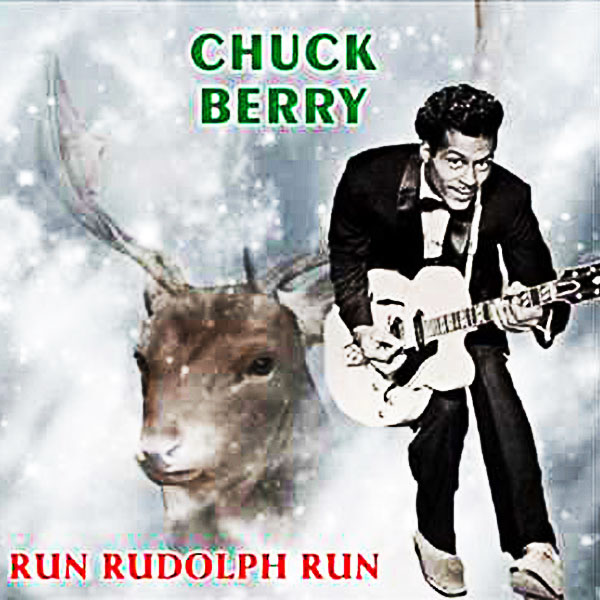
Chuck Berry, “Run Rudolph Run” (1958) 
Dean Martin, “Let It Snow, Let It Snow, Let It Snow” (1945 / 1966) 
Wham!, “Last Christmas” (1984) 
Nat King Cole, “The Christmas Song (Merry Christmas to You)” (1945 / 1946) 
Kelly Clarkson, “Underneath the Tree” (2013) 
Continued ...
Mariah Carey official site (Mariah Carey Discography) / Rock & Roll Hall of Fame / Billboard / All Music / Song Facts /
Ultimate Classic Rock / Mariah Carey
Image: “Merry Christmas (album)” by Mariah Carey
CHRISTMAS MOVIES

“Every Time a Bell Rings an Angel Gets His Wings:”  An angel is sent from Heaven to help a desperately frustrated businessman by showing him what life would have been like if he had never existed.
An angel is sent from Heaven to help a desperately frustrated businessman by showing him what life would have been like if he had never existed.
It's a Wonderful Life is a 1946 American Christmas fantasy drama film produced and directed by Frank Capra. Based on the short story and booklet “The Greatest Gift”, which Philip Van Doren Stern self-published in 1943, and is in turn loosely based on the 1843 Charles Dickens novell “A Christmas Carol”.
The film stars James Stewart as George Bailey, a man who has given up his personal dreams, in order to help others in his community, and whose thoughts of suicide on Christmas Eve brings about the intervention of his guardian angel, Clarence Odbody (Henry Travers).
Clarence shows George how he has touched the lives of others and how different life would be for his wife Mary (Donna Reed). and his community of Bedford Falls if he had not been born.
Continued ...

Trivia
Eight (no Rudolph!) reindeer are featured in the poem “Twas the Night Before Christmas?”
A Charlie Brown Christmas: In dictating a letter to Santa, Sally ultimately asks Santa for one gift - “Just send money. How about tens and twenties?”.
In the early 1800s, the first gingerbread houses were reportedly inspired by the famous fairy tale “Hansel and Gretel”.
Coca-Cola has been using Santa Claus in its advertising since 1931.
The Nutcracker a Christmas-themed ballet premiered in Saint Petersburg, Russia in 1892.
The Christmas edible Fruitcake is known for its long shelf life.
● What Christian group banned Christmas in Boston from 1659 to 1681?
Answer to Trivia
READ MORE: History Channel
● Before becoming associated with Christmas what was Yule?
Answer to Trivia
READ MORE: Wikipedia
● What Roman holiday held from December 17th to the 23rd had a large influence on how Christmas was celebrated?
Answer to Trivia
READ MORE: History Channel
● Among Christians who lived in the East, when was Christmas originally celebrated?
Answer to Trivia
READ MORE: Wikipedia
● In what century was the first written use of Xmas?
Answer to Trivia
READ MORE: The Voice.org
● The modern Santa Claus is mainly a mix of what two figures?
Answer to Trivia
READ MORE: Wikipedia
● What political cartoonist is largely responsible for defining what the modern Santa Claus looks like?
Answer to Trivia
READ MORE: Wikipedia

A Test for People Who Know Everything
From the Jeopardy Archives Category - “INTERNATIONAL YULETIDE” ($200)
“Thanks to smart marketing, many in Japan celebrate Kentucky Christmas eating this for dinner.”
Answer to Jeopardy READ MORE: Tokyo Creative
From the Jeopardy Archives Category - “INTERNATIONAL YULETIDE” ($400)
“Buche de Noel is a chocolate sponge cake resembling a yule this.”
Answer to Jeopardy READ MORE: All Recipes
From the Jeopardy Archives Category - “INTERNATIONAL YULETIDE” ($600)
“This is a Christmas staple in Latin America, although some in Central America use banana leaves instead of corn husks.”
Answer to Jeopardy READ MORE: Texas Cooking
From the Jeopardy Archives Category - “INTERNATIONAL YULETIDE” ($800)
“In Britain, the alliterative ‘Christmas’ this is not a baked good, but a party favor that pops when you pull it open.”
Answer to Jeopardy READ MORE: Wikipedia
From the Jeopardy Archives Category - “INTERNATIONAL YULETIDE” ($1,000)
“In the Bahamas, everyone dances in the streets for the Junkanoo celebrations on New Year's & this December 26 holiday.”
Answer to Jeopardy READ MORE: Wikipedia

Joke of the Day

“Christmas Jokes”
Q: What do Santa’s elves learn in school?
A: The Elfabet.
Q: What do Santa’s elves drink?
A: Minnesoda.
Q: What does Santa like to do in the garden?
A: Hoe, hoe, hoe!
Q: What is Claustrophobia?
A: The fear of Santa Claus.
Q: What breakfast cereal does Frosty the Snowman eat?
A: Snowflakes.
Q: Where does the snowman hide his money?
A: In the snow bank.
Q: What do you get when you cross a Christmas tree with an apple?
A: A pineapple!
Q: Why does everybody like Frosty the Snowman?
A: Because he is so cool!
Q: What kind of Christmas music do elves like?
A: “Wrap” music.
Q: Which reindeer likes to clean?
A: Comet.
Q: How can Santa deliver presents during a thunderstorm?
A: His sleigh is flown by raindeer.
Q: What do you call a snowman with a six pack?
A: An abdominal snowman.










































